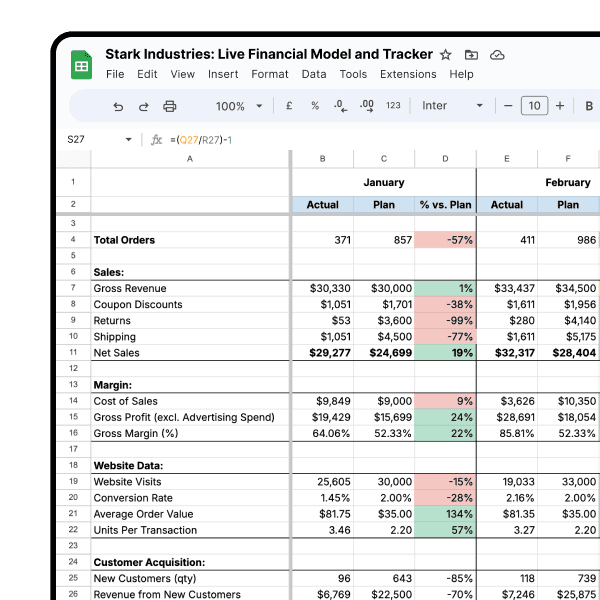Tools & Templates
Apr 24, 2025
What we'll talk about
All you need to know about our proprietary inventory forecasting model.
Effective inventory forecasting is essential for optimizing stock levels, improving cash flow, and meeting customer demand. Airboxr’s Inventory Forecasting Template simplifies this process by leveraging historical data and data modeling techniques to provide actionable insights. Here’s a detailed breakdown of how this works and how to use it effectively.
Methodology: How the Forecasting Works
Airboxr’s template uses a combination of historical and current sales data to predict future inventory needs. Here’s the step-by-step approach:
Data Collection:
The model pulls three years of historical sales data of your product variants. This is to capture seasonal patterns, trends, and variability for more accurate and reliable predictions.
It also incorporates the current year’s sales performance data.
This information is sourced from the Variant Sales Performance Over Time report, which consolidates and transforms the data in the background.
Forecasting Model:
A linear forecasting model is applied, integrating a monthly seasonality index. This ensures that predictions account for seasonal trends and align with historical sales patterns.
The result is a realistic and accurate forecast tailored to your business needs.
Why is this methodology better than others?
Many inventory management platforms offer special features like ‘automatic ordering’ or ‘dynamic forecasting’; however, they typically use a maximum of 90 days sell-through rate to determine their forecast.
Our proprietary model factors in sales seasonality over the past 3 years for your specific store, so the forecast is tailored specifically to your business.
Selecting the Top 20 SKUs
To prioritize inventory decisions, Airboxr helps identify the top 20 SKUs (stock-keeping units) based on specific criteria:
Data Source:
The Sell Through Rate by Product Variant report is used. We recommend this report covering sales trends from the last 90 days.
Selection Criteria:
Total Sales (Weight: 65%): Identifies top-selling products.
Estimated Days of Inventory (Weight: 35%): Highlights products that are likely to run out soon or have already run out.
We decided to weigh both metrics this way in order to prioritise your products in an optimal way.
Exclusions:
SKUs with more than 90 days of estimated inventory are excluded from consideration since they represent at least three months’ worth of stock.
Scoring System:
After data processing, each SKU is assigned a score based on its total sales and inventory urgency. This score ranks products by their importance for reordering, ensuring that top-selling items with low stock levels are prioritized.
SKU Shortlist and Forecasting
Once the top 20 SKUs are identified, they are displayed in the SKU Shortlist tab within the template. Here’s what you can do next:
User Selection: Choose which SKUs you want to forecast for the next six months.
Custom Additions: Add other SKUs of your choice to include in the forecast.
This flexibility allows users to focus on critical products while also accommodating specific business needs.
How to Set Up and Use the Inventory Forecasting Template
Here’s a video explaining how to set up our inventory forecasting template:
It is important to note that forecasting is only as good as the data it’s built on. Stores with limited historical data may face challenges. For example, a store with only six months of sales history will inherently have less reliable forecasts compared to one with three years of data. This is because seasonal trends, annual fluctuations, and product lifecycle patterns require time to emerge in the data. Similarly, forecasts for relatively new SKUs are also more likely to be inaccurate. Over time, as more historical data accumulates, forecasts will become increasingly precise, enabling smarter inventory decisions.
Use Cases for E-Commerce Businesses
Airboxr’s Inventory Forecasting Template offers a range of applications for e-commerce businesses, helping you optimize operations, improve decision-making, and enhance profitability. Here are some key use cases:
1. Inventory Management
Stock Replenishment: Identify top-selling SKUs that are running low and prioritize reordering to avoid stockouts.
Seasonal Planning: Incorporate seasonality trends into forecasts to ensure adequate inventory during peak sales periods.
Overstock Prevention: Avoid tying up cash in excess inventory by accurately predicting demand.
2. Sales Performance Analysis
Slow-Moving Inventory: Pinpoint underperforming items and develop strategies to clear them, such as discounts or bundling.
3. Financial Planning
Cash Flow Optimization: Monitor inventory levels and sales trends to allocate resources efficiently.
4. Marketing Strategy
Campaign Planning: Align inventory forecasts with marketing campaigns to ensure stock availability for promoted items.
Customer Segmentation: Identify products popular among specific customer segments and tailor promotions accordingly.
5. Operational Efficiency
Warehouse Management: Improve storage planning by forecasting which products will move faster.
3PL Coordination: Share accurate forecasts with third-party logistics providers to streamline fulfillment processes.
Improve your DTC game. Sign up for weekly tips.
Why Use Airboxr’s Inventory Forecasting Template?
Our Inventory Forecasting Template streamlines the often-complex process of inventory management by combining automation with actionable insights. By focusing on high-priority SKUs and incorporating seasonality into forecasts, your business can reduce stockouts, avoid overstocking, and make data-driven decisions about reordering.
Feel free to reach out to us in our app chat if you have any questions.
FAQs:
Is Airboxr’s Inventory Forecasting Template easy to use?
As the template is built on Google Sheets, all you need to do to gain access is to make a copy of the spreadsheet.
To set it up, you need to input your past 3 years’ worth of sales data, as well as sell-through rate analysis for the last 90 days. You can easily do this by using Airboxr and following the instructions on the spreadsheet.
Is the template free?
Airboxr’s proprietary Inventory Forecasting Template is free to download and use. You can input your own data, or use the Airboxr platform to run the reports that populate the template.
The Airboxr team can also help you with implementation and present the findings for a fee. For the most updated prices, check our Pricing Table.
This service is also included in our Enterprise Plan or if you purchase our Implementation Package.
How is Airboxr’s Inventory Forecasting model better than the forecasting on other platforms?
Your inventory management platform may offer special features like ‘automatic ordering’ or ‘dynamic forecasting’. However, they typically use a maximum of 90 days sell-through rate to determine their forecast.
Our proprietary model factors in sales seasonality over the past 3 years for your specific store, so the forecast is tailored specifically to your business. We have the flexibility of making more accurate forecasts for your evergreen products, while still being able to plan purchase orders for newer products.
Why is the Inventory Forecasting model better in a spreadsheet?
The best way to plan inventory is still in a spreadsheet. It’s lightweight and gives you a lot of control over what products should be selected and which should not.
Having the Inventory Forecasting model on a spreadsheet gives you the ability to create your forecast, review it, and then modify it according to your own specifications. No two businesses are the same; with the forecasting model in a spreadsheet, you have the ability to select and deselect SKUs to forecast for, create special groupings, and make any other modifications you may need.


